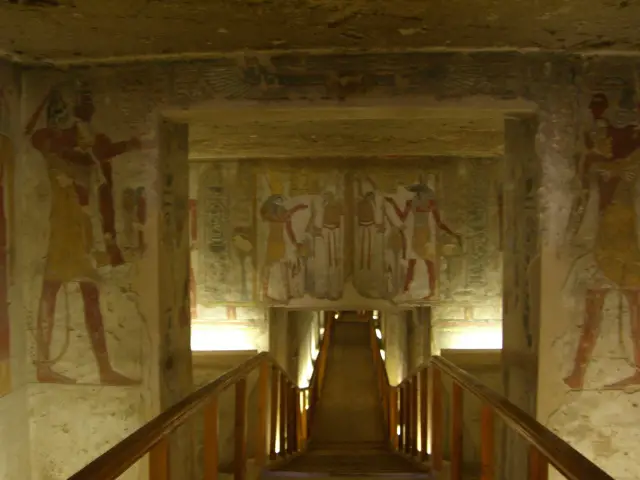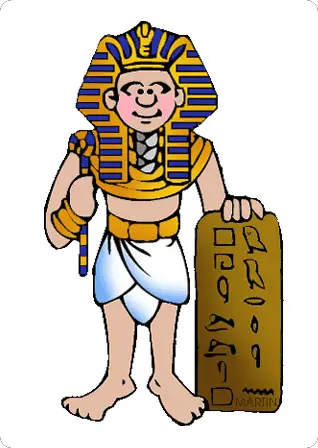Ancient Egyptian Tombs
The tombs of the Ancient Egyptians were a place where people would be buried when they died. This was important to the Egyptians because they believed that life continued even after someone died, as long as they were buried properly in their tomb.
Ancient Egyptian tombs were elaborate structures built to house the bodies of pharaohs and their consorts. These tombs were filled with treasures and offerings to ensure the pharaoh’s safe passage to the afterlife. The most famous of these tombs is the tomb of Tutankhamun, discovered by Howard Carter in 1922, which contained a wealth of artifacts and information about life in ancient Egypt.

Egyptian Mummification
Mummification was integral to ancient Egyptian burial customs and was closely linked to tomb usage. The goal was to preserve the body for the afterlife through a process involving organ removal, desiccation, and bandaging. Once mummified, the bodies were housed in tombs adorned with texts and images to guide the soul in the afterlife.
Decorations often depicted the mummification process and associated rituals. Tombs also housed items used in mummification, such as canopic jars and ushabtis, signifying the close relationship between mummification and tomb construction.
Egyptian Pyramids

Egyptian Pyramids are iconic symbols of ancient Egyptian tombs. Primarily built for pharaohs, these tombs were filled with artifacts to support the deceased in the afterlife. The Pyramids of Giza, including the Great Pyramid of Pharaoh Khufu, exemplify the scale and grandeur of these structures.
Serving more than just burial purposes, pyramids were spiritual platforms assisting the pharaoh’s ascension to the divine realm. Therefore, pyramids, through their design and purpose, encapsulate ancient Egyptian beliefs about death and the afterlife.
Egyptian Hieroglyphics
Egyptian hieroglyphics were integral to ancient Egyptian tombs, offering both spiritual and historical significance. Inscriptions on tomb walls and sarcophagi detailed the deceased’s life, provided protective spells, and guided the afterlife journey, as seen in the Pyramid Texts and the Book of the Dead. These hieroglyphs also give archaeologists insights into ancient Egyptian culture and religion, making them valuable records within tombs.
Egyptian Mythology and Religion
Egyptian mythology and religion shaped the design and function of their tombs, reflecting the ancient Egyptians’ belief in life after death. This belief necessitated the tombs’ preparation as eternal dwellings for the ka, the spirit of the deceased. Tombs were filled with everyday items, food, and treasures, along with protective symbols and inscriptions.
Depictions of gods, goddesses, and scenes from religious texts adorned many tombs. The tombs’ architecture and orientation were symbolic, embodying cosmological beliefs. For example, the pyramid shape represented the sun god Ra’s primordial mound of creation. Hence, tombs were not merely final resting places, but sacred spaces symbolizing the interaction of death, the afterlife, and divinity in ancient Egyptian beliefs.
Old Kingdom (c. 2686–2181 BC)
This era is known for the construction of step pyramids and true pyramids. The Step Pyramid of Djoser is considered the earliest colossal stone building and the earliest large-scale cut-stone construction. True pyramids, such as the Great Pyramid of Giza built for Pharaoh Khufu, are some of the most iconic examples of ancient Egyptian tombs. These structures were built as royal tombs, symbolizing the king’s absolute power and divine status.
Middle Kingdom (c. 2050–1710 BC)
During this period, kings were buried in hidden tombs in a cliffside complex called the Valley of the Kings, near modern-day Luxor. The royal tombs were increasingly separated from mortuary temples, which remained on the floodplain. The tombs of non-royal elites were often decorated with scenes of daily life, reflecting the belief that these activities would continue in the afterlife.
New Kingdom (c. 1550–1070 BC)
This era saw the peak of the Valley of the Kings, with elaborate tombs dug deep into the valley’s rock for pharaohs such as Tutankhamun, Seti I, and Ramesses II. The tombs were filled with artworks, jewelry, furniture, and other objects to accompany the deceased in the afterlife, following the belief that the ka needed to enjoy the same lifestyle it had while alive. The walls were often inscribed with passages from the Book of the Dead, a collection of spells and instructions to aid the deceased in navigating the afterlife.
Late Period (c. 664–332 BC) and Ptolemaic Period (305–30 BC)
During these periods, some tombs featured complex networks of chambers and corridors, often with elaborate decorations. Sarcophagi became more prominent, often carved with intricate scenes and inscriptions. Animal burials also became common, as certain animals were believed to be embodiments of specific deities.
Valley of the Kings

The Valley of the Kings, located opposite Thebes (now Luxor), was the main burial site for pharaohs during the New Kingdom period (c. 1550–1070 BC). This marked a shift from the grand pyramids of the Old Kingdom to hidden tombs, which were built to secure the kings in the afterlife and protect them against grave robbers.
Over 60 royal tombs have been discovered, each adorned with elaborate art and filled with items for the afterlife. Among these, King Tutankhamun’s tomb found intact in 1922, is the most famous. This valley showcases the evolution of ancient Egyptian beliefs about death and the afterlife.
Egyptian Pharaohs
Egyptian Pharaohs, as divine rulers, had grand tombs reflecting their status. These tombs, from the Old Kingdom’s pyramids to the New Kingdom’s hidden burials in the Valley of the Kings, exhibit the period’s architectural styles and religious beliefs. Filled with valuable artifacts, these tombs were prepared for the Pharaoh’s spirit, or ka, in the afterlife.
Decorations depicted the Pharaoh’s journey in the afterlife, underlining the spiritual significance of these tombs. The discovery of tombs like Tutankhamun’s provides deep insights into ancient Egypt’s rulers and customs.
Egyptian Art and Architecture
Ancient Egyptian tombs showcase the civilization’s art and architecture. Their design varied from the Old Kingdom’s pyramids to the New Kingdom’s rock-cut tombs in the Valley of the Kings, reflecting evolving architectural skills. These tombs were also adorned with intricate reliefs, frescoes, and hieroglyphic inscriptions that depicted religious rituals and daily life, often meant to guide the deceased in the afterlife.
Furthermore, the elaborate funerary artifacts within these tombs highlight the era’s craftsmanship. Hence, the art and architecture of these tombs provide insights into ancient Egypt’s aesthetic values and beliefs.
Archaeology in Egypt
Archaeology in Egypt has been defined by the study of ancient tombs. These tombs have offered insights into the civilization’s social, religious, and artistic practices. Landmark discoveries like Tutankhamun’s tomb have fueled global interest in Egyptology.
However, archaeologists face challenges such as artifact preservation, tourism impact, and illicit antiquities trade. Now, technologies like ground-penetrating radar and 3D imaging help study these tombs with minimal intrusion. Hence, the study of these tombs is vital to understanding ancient Egypt.
Treasures and Artifacts
Ancient Egyptian tombs were filled with treasures and artifacts, offering insights into the civilization’s beliefs and lifestyles. Items for the afterlife, precious jewelry, and symbolic statues were common. The golden mask of Tutankhamun is a notable example, symbolizing his power.
Artifacts like decorated sarcophagi, canopic jars, and ushabti figurines reveal the technical skills of the craftsmen and societal norms. Hence, these tomb contents are valuable resources for understanding ancient Egypt.
Egyptian Book of the Dead
The Egyptian Book of the Dead played a significant role in ancient Egyptian tombs. This collection of funerary texts provided guidance and protection for the deceased in the afterlife. Placed within tombs, it contained spells, rituals, and instructions for navigating the divine realm.
Scenes from the Book of the Dead, such as the weighing of the heart, were depicted on tomb walls, reinforcing the belief in judgment and eternal life. Its inclusion in ancient Egyptian tombs reflects the deep religious convictions and the pursuit of a favorable afterlife
Tombs
It was after the pyramids became unpopular that people begin to bury the dead in tombs. Even though many people had already buried the dead in tombs, it was a time when the royal families begin using tombs too.
The tombs were loved by the Ancient Egyptians and they would work in them and on them so that they could be nice when their friends and families died.
Places to Visit
The tombs were so loved by the Ancient Egyptians that they would sometimes go out to visit them when they were on an outing.
The families would load up and take a bunch of grave goods to leave in the tombs.
Grave Goods
Many of the grave goods that were found in the tombs were amulets, jewelry, toys, dolls, and other fun things that their loved one could have when they went to the afterlife.
Name
A name was very important in Ancient Egyptian times, especially for someone who died. It was believed that when someone died, their name had to be written on their coffin or be found somewhere close to the body.
The reason the person had to have a name was that the Egyptians believed that there were two parts to the soul: the Ba and the Ka. When a person died, the Ba would go and would have fun and enjoy its life, and the Ka would go and take care of the family. At night though, the Ba and Ka would come together at the tomb of the body and the mummy would get a restful sleep.
If the name was not on the tomb, the Ba and Ka could not know which way to go and the person could be lost out of the afterlife forever. If you were lost in the afterlife, you would disappear and never come back again.
Writings
Families loved to write, and they would write stories and poems and draw pictures on the tombs of their loved ones. They would also write on their own tomb and talk about the good things that they had done in their life.
The people always wanted the gods to know what they had done so when it was their time to die, that the gods would allow them to go to the afterlife.
In order to go to the afterlife, the person had to do good deeds and keep a light heart.
Facts About Ancient Egyptian Tombs:
- Many kings and pharaohs had masks that were found in their tombs.
- Sometimes things inside the tomb were made out of solid gold.
- Canopic jars were often found inside the tombs and these are jars that hold the organs of the dead person.
- When Egyptians were buried in the tombs, their family and friends would bring food for them to have something to eat in the afterlife.
- There have even been boats that have been found in some tombs.
What Did You Learn?
- What is interesting about the tombs of Ancient Egypt? When people were first buried, they were buried in pyramids. This became too expensive and people started burying their loved ones in tombs.
- What are some things that might be found in a tomb? Some things found in tombs could be jewelry, amulets, food, canopic jars, boats, and more.
- Why did the people write things about themselves on the walls of their own tombs? People would write about themselves on their own tombs because they wanted the gods to know all of the good things that they did so they could make it to the afterlife.
- Were people sad to visit the tombs? No! People would make family outings just so they could go and visit the tombs of people they knew.
- Why was it important for a name to be written somewhere in the tomb? The Ancient Egyptians believed that the person’s name had to be written in their tomb or on their coffin so that the Ba and Ka could come and let the mummy have good sleep. This was also to protect the dead person so they could get to the afterlife.



